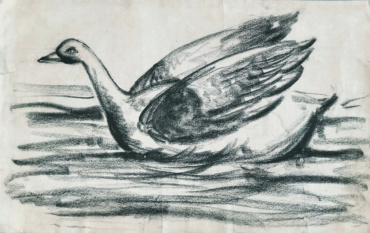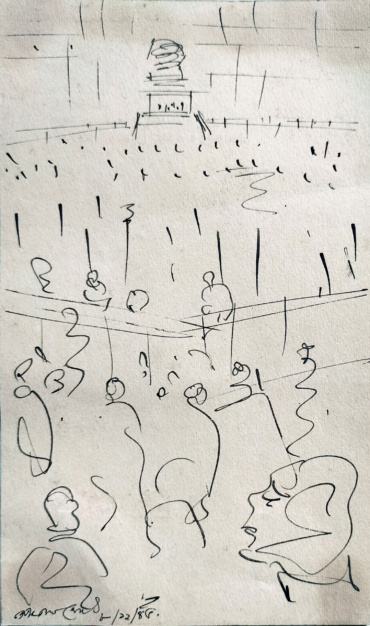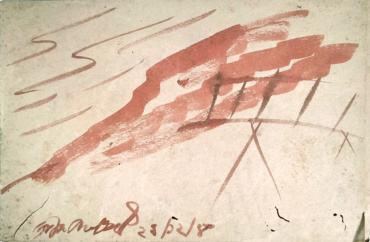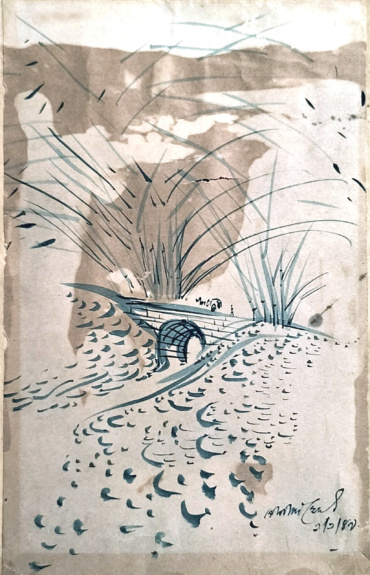What happens exactly, the moment we approach a canvas?
While keeping all the ideology and the opinions about art and the ideas about method or techniques slightly aside and staying away from logic-debate-likes-dislikes, what primarily takes place at the time of facing a canvas is happy conjuncture of two visions. The eyes of the viewers get united with the eyes of the art as well as the artist. Whether this union would develop a steady stroke in the framework of co-existence of the author of the canvas and his viewers or it would perpetrate an impending gloom of separation between them–that would be determined in the second or third phase. This vision indicates unification. But at the completion of the first phase when the vision of the creator and the one who enjoys the creation come across each other then only the other phases will follow. Thus, perhaps the connection of visions is an integral part of the art of painting.
Now, beyond this union of vision lies a vision or view which is all the more significant. This vision belongs to the artist or creator. When the vision becomes more intense and profound and whatever the creator perceives through this vision, from the outer most to the inner quarter and when this vision touches the invisible, surpassing the range of visibility of a scenario like a sharpened weapon, then the philosophy of imagery emerges from the vision of the creator. This search is rare and may also be termed as ‘perseverance’.
And then only, the one who appreciates tends to open his eyes because of the moment when a scenario materializes; and now the art lover rushes towards that freshly produced scene in pursuit of a rhythm deep within. The artist who is sagacious as well as visionary extends his hand and leads the connoisseurs to the world of painting by bridging the gap. This indicates a unification that echoes throughout the inner self of the viewer. Not that everyone can request the presence of the viewers in the journey from vision to canvas. They may only send an invitation. They are the persons who employ their days, from dawn to dusk in pursuit of the thrill of searching, in exaltation of discovery and in melancholy as well. Gopal Ghosh is one of them.
Even after proceeding so long, can we really discard the issue, namely, ‘brilliance of imagination’ as coined by Jibanananda Das for the poets? Similarly, Gopal Ghosh, at the end of his lifelong travail reaches a realization that vision does not connote any ordinary observation, it ought to be something all pervasive.
The way, the brilliance of imagination in Jibanananda abounds in his rhythm of vision, similarly in Gopal Ghosh invisible becomes visible through his
all-pervasive observation.
Gopal Ghosh who was born in 1913, observed his birth centenary a decade ago. His childhood was spent in the natural surroundings of Simla because his father worked as a military captain. Due to repeated transfer in his father’s professional career, Gopal Ghosh had to shift from one place to another, and during the course of his journey, observation became his constant companion, In the course of his stay in Allahabad, he passed his Matric Examination and started pursuing I. A. Course. But he got involved in the Non-Cooperation Movement that resulted into his rustication from the college. Later he got enrolled in the Jaipur Maharaja Art School to study art. Then Sailendranath Dey, a disciple of Abanindranath was the vice-chancellor, and under his tutelege Gopal Ghosh studied Bengal Art. He stood first with a first class in the college examination and after being influenced by Debiprasad Roychaudury he got admitted in the Government Art School in Madras and continued his study. He again secured the first position with a first class. Now being driven by the urge to explore, he set off on his bicycle to make a journey through the country. Since 1938, he permanently settled in Kolkata and an illustrated version of his travelogue was published in a magazine called ‘Bangashree’ and it started receiving accolades from those who appreciated. After spending a few days of his professional career at the Scottish Church College and the B.E. College, Sibpur, he joined Oriental Society of Indian Art as a teacher by wish of Abanindranath. Therefrom, Ramendranath Chakraborty, the principal brought him to the Government Art School as a teacher.
During the course of the journey of life of Gopal Ghosh, what remained constantly ignited in him was his vision, as if he was destined to be a visionary. When we go through the private collection of Bishnu Dey (who was truely an artist by temperament) in this exhibition comprising of Gopal Ghosh’s strokes and shades don’t we find how did he, Gopal Ghosh translate the rhythm of his vision with the nimbleness of lighting? His lines seem to appear on the surface of the paper with the flash of a lighting along with his vision. Where is the bird? The bird comes to life in front of our eyes by his strokes; the countenance of a child created by his strokes replicates the child playing at the corner of our home. The artist renders us spellbound, the way he left us awestruck by mingling together pastel and water colour.
In nature the theatres are being acted out, the poetic literatures are being composed, the tunes of classical music float all around, the sunshine embraces water, the gush of wind often puts out the flame of light or the excitement generated by the cheerfulness or the melancholic stupor–all of them are vibrantly present on the canvas of Gopal Ghosh, the vivacity of his hues ignites melodies. This blaze is not only present in his shades of colours, his strokes also carry their warmth. Even in this very short exhibition one may get the feel of his blazing melody that Gopal Ghosh experienced through his vision. The principal artists of today’s Bengal like Ganesh Haloi, Jogen Chowdhury and Lalu Prasad Shaw–once they all had Gopal Ghosh as their ‘teacher’ in their college life and their reminiscences reveal how Gopal Ghosh keenly observed each of the flowers, birds and insects. In fact, this observation evoked in him a lifelong jubilation of discovery.
From the article written by Kalpana Ray, we came to know about Ustad Alauddin Khan who once regretfully declared even after touching the pinnacle of his musical career, ‘I am tuneless, good-for-nothing. I could never touch the right cord in my life.’ He added, ‘In my life, I could manage to touch the cord, ‘Sa’ properly only three to four times.’ We feel dumbstruck, after experiencing Gopal Ghosh on a similar note. Those who attained perfection in their art of either practicing music or painting, their pursuit is never ending.







